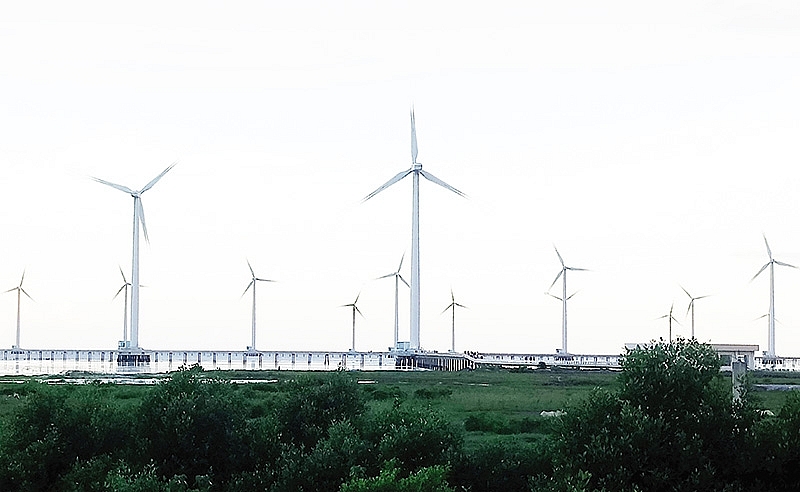Calls for removal of energy obstructions
 |
| Vietnam is among those hardest-hit by climate change, but renewables investment is slow |
Last Wednesday, Hanoi hosted an event of high significance: the launch of the “Special Report on Global Warming of 1.5 degrees Celsius” by the Intergovernmental Panel on Climate Change (IPCC). The report was approved only a few days prior, and Vietnam was selected as the first country to share this important research.
According to the IPCC, the event was important for Vietnam, as the country is one of the countries in the world to be hit hardest by climate change. It also remains at a slow pace in reducing greenhouse gas emissions and enabling private investors to invest heavily into renewable energy (RE) projects. It is acknowledged the country can attract more of this type of investment if it removes obstructions against investors.
Caitlin Weisen, United Nations Development Programme (UNDP) country director in Vietnam, said that the country has great potential for RE. Vietnam can deploy at least 85 gigawatts (GW) of solar photovoltaic generation capacity and 21GW of wind energy generation well before 2050, showing that a low-carbon pathway is possible. The combined total technical capacity (126 GW) is an equivalence of 80 per cent of Vietnam’s total installed energy capacity by 2030 (129.5 GW).
Vietnam also boasts high potential for energy-saving of up to 7 per cent relative to business as usual, through to the year 2035. Energy efficiency (EE) measures can remove some 67 million tonnes of carbon dioxide equivalent (CO2e) by 2035 as well as deliver additional environmental benefits.
“Cutting across all climate efforts is of importance to enabling the access, contribution and involvement of the private sector,” Weisen said.
A recent UNDP survey of 13 large banks, institutions, and investors show that there is at least $10 billion readily available for investment in RE and EE in Vietnam, amounting to almost 40 per cent of the total investment required by Vietnam by 2030.
“This investment is possible if the current barriers constraining such investments are addressed, especially the low price of electricity that lowers incentives for efficient use, and the existing format of power purchase agreements (PPAs) that deter investors from investing,” read a UNDP report on private funding opportunities for RE and EE investments in Vietnam, released last week.
A foreign bank representative said that it stands ready to invest $1 billion into around 10 RE projects in the country. “However, the bank’s engagement in Vietnam’s RE market is presently being prevented by PPAs that are deemed un-bankable,” the representative said.
Another bank also revealed that it has $10 billion set for RE investment loans worldwide, and would be happy to become engaged in RE investments in Vietnam. “The bank could theoretically offer up to $1 billion for Vietnam, but currently has several major concerns about the PPA framework that prevent its full engagement,” a bank source said.
A third bank also stated that if the regulatory framework was simplified it could provide $500 million annually for RE and EE in Vietnam’s state-owned enterprises through concessional loans, as well as provide another $500 million annually for project preparation. “However, Vietnam’s Law on Public Investment procedures are too long – larger projects may take several years to develop during which time procedures may change,” the bank’s spokesperson said. “Moreover, flexible credit lines related to RE/EE are effectively not allowed since most RE projects have to be approved by the prime minister, which further complicates lending.”
The Ministry of Industry and Trade (MoIT) has approved over 70 new solar power projects to be put into operation before June 2019, with a total designed capacity of over 3,000 megawatts (MW).
According to pan-Asia consulting firm Dezan Shira & Associates, as of July, solar power projects with a total capacity of 12,600MW were in the pre-investment phase, while 1,430MW was in the development and feasibility phase. Around 1,000MW is under construction, while only 8MW is currently in the operating stage. Also, 748 solar roof-top projects were in operation with a total capacity of 11.55MW.
Last year the Vietnamese government issued Decree No.11/2017/QD-TTg on mechanisms for encouraging the development of solar power in Vietnam, offering a feed-in-tariff (FiT) for utility solar power plants of 9.35 US cents per kilowatt an hour (kWh) for 20 years. The FiT will be applicable for projects beginning operations before June 30, 2019, except for those in the south-central province of Ninh Thuan, which have a 2020 deadline.
Currently the FiT for wind power is set by the Vietnamese government at 7.8 US cents per kWh. However, this price will be increased to 8.5 US cents as November 1.
What the stars mean:
★ Poor ★ ★ Promising ★★★ Good ★★★★ Very good ★★★★★ Exceptional
 Tag:
Tag:
Related Contents
Latest News
More News
- Heavy industries set for pilot greenhouse gas quotas (December 25, 2025 | 10:00)
- Swedfund invests in MSME growth and climate action in Vietnam (December 19, 2025 | 11:42)
- GreenYellow brings solar energy to light up remote schools in Tuyen Quang province (December 19, 2025 | 08:00)
- Charge+, Grab partner to develop EV charging network in Vietnam (December 18, 2025 | 17:11)
- Linking sci-tech and innovation to Vietnam’s net-zero future (December 18, 2025 | 14:31)
- Driving double-digit growth through green and circular transformation in Vietnam (December 17, 2025 | 09:00)
- Standard Chartered and ACCA deepen collaboration to develop Vietnam’s talent for a sustainable future (December 15, 2025 | 18:18)
- Schaeffler reports strong early output from Dong Nai solar project (December 12, 2025 | 15:16)
- Forestry conference highlights biodiversity and sustainability goals (December 09, 2025 | 13:35)
- Home Credit honoured among top 10 sustainable companies in trade and services (December 09, 2025 | 12:18)






















 Mobile Version
Mobile Version